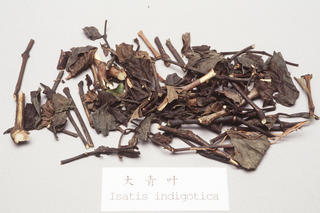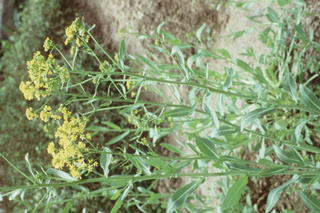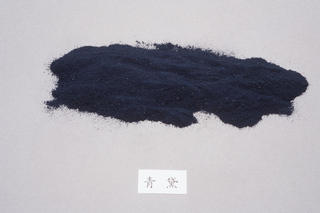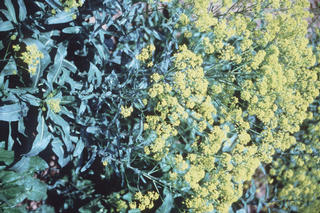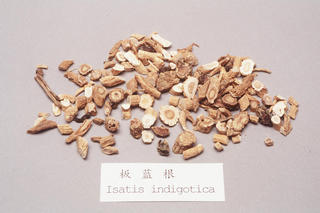Isatis indigotica
Contents
- 1 Nomenclature
- 2 Historical Use of Isatis indigotica
- 3 Background
- 4 Nomenclature
- 5 Historical Use of Isatis indigotica
- 6 Background
- 7 Nomenclature
- 8 Historical Use of Isatis indigotica
- 9 Background
- 10 Pharmaceutical Information
- 11 Evidence or the Use of Isatis indigotica in the Treatment of Epilepesy
- 12 Safety
Nomenclature
Other Names:
Historical Use of Isatis indigotica
Isatis indigotica in Traditional Chinese Medicine
Background
Chinese Name (pinyin): Daqingye
Chinese Name :
Common Name :Isatis Leaf
Specific Name : Folium isatidi
Scientific Name:
Collection : The drug is collected 2 - 3 times in summer and autumn, removed from foreign matter and dried in the sun.
Description : Mostly crumpled and rolled, sometimes broken. When whole, long elliptical to oblong-oblanceolate 5 - 20cm long, 2 - 6cm wide, upper surface dark greyish green, sometimes small deeper coloured prominences being visible, apex obtuse, margins entire or slightly undulate, base attenuate and decurrent into the petiole appearing wing shaped, petioles 4 - 10 cm long, pale brownish yellow. Texture fragile, odour slight, taste slightly sour, bitter and astringent.
Identification : 1.Powder: greenish brown, anticlinal walls of lower epidermal cells slightly sinuous and somewhat beaded, stomata anomocytic, with 3 - 4 subsidiary cells. Transverse section of mesophyll indistincly differentiated into palisade tissue and spongy tissue.2.To 0.5g of the powder add 20ml of chloroform, heat under reflux on a water bath for 1 hour, filter and evaporate the filtrate to 1ml as the test solution. Dissolve indigotin CRS and indrirubin CRS in chloroform to produce a solution containing 1mg of each per ml as the reference solution. Carry out the thin layer chromatography (Appendix Vl B), using silica gel G as the coating substance and benzene-chloroform acetone (5:4:1) as the mobile phase. Apply separately to the plate 5µl of the two solution. After developing and removal of the plate, dry it in tha air. The blue spot and pale purplish red spot due to indigotin and indirubin in the chromatogram obtained with the test solution correspond in position and color to the spots in the chromatogram obtained with the reference solution
Processing : Eliminate foreign matter, wash rapidly, cut into pieces and dry.
Action : To remove toxic heat, reduce heat in blood, and to promote subsidence of eruptions.
Indication : high fever with impairment of consciousness with skin eruptions in epidemic disease, jaundice, acute dysentery, mumps, inflammation of the throat, erysipelas, carbuncle
Precautions :
Dosage : 9 to 15 g.
Storage : Preserve in a ventilated dry place, protected from mould.
Nomenclature
Other Names:
Historical Use of Isatis indigotica
Isatis indigotica in Traditional Chinese Medicine
Background
Chinese Name (pinyin): Qingdai
Chinese Name :
Common Name :Natural Indigo
Specific Name : Indigo naturalis
Scientific Name:
Collection :
Description : Description: a deep blue powder, light and pufffy or irregular and porous masses, finely powdered on twisting, odour slightly grassy and taste weak.
Identification : 1.Burn gently small quantity of powder, a purplish red smoke is produced.2.To a small quantity of the powder, add nitric acid dropwise, a brownish red or yellowish brown colour s produced with effervescence.3.To 50mg of the drug add 5ml of chloroform, stir well and filter, the filtrate used as the test solution. Dissolve indigo CRS and indirubin CRS in chloroform to prepare a solution containing 1mg of each per ml. Use as the reference solution. Carry out the method for thin layer chromatography (Appendix Vl B), using silica gel G as the coating substance and benzene-chloroform-acetone (5:4:1) as the mobile phase. Apply separately to the plate 5 - 10µl of each of the two solutions. After developing and removal of the plate, dry it in the air. The blue spot and pale purplish red spot in the chromatogram obtained with the test solution correspond in position and colour to the spots in the chromatogram obtained with the reference solution.Water soluble pigment: Shake 0.5g of the powder with 10 ml of water and allow to stand for a moment, the water layer shows no deep blue colour.Assay: Reference preparation: Sulfonate 20mg of indigo CRS accurately weighed in a flask by adding 15ml of sulfuric acid slowly and with a constant stiring gently on a water bath at 80ºC for 1 hour. Allow to cool, transfer the solution slowly to a 200ml volumetric flask containing a quality of water. Wash the flask and the residue with water. Combine the washing to a volumetric flask, add water to volume and mix well. Filter and discard the initial filtrate. Measure accurately 5ml of the successive filtrate to a 50ml volumetric flask, add water and mix well (containing 10µg of indigo per ml.Preparation of standard curve: Measure accurately 1.0, 2.0, 3.0, 4.0, and 5.0ml of the reference solution respectively into a 10ml volumetric flask, add water to volume and mix well. Carry out the method for spectrophotometry (Appendix V B). Measure the absorbance at 610nm and plot the standard curve using the absorbance as ordinate and concentration abscissa.Procedure: Weigh accurately 0.4g of the fine powder, carry out the procedure as described under reference preparation, beginning at the words "in a flask Media wiki admin 13:21, 29 November 2012 (EST)" to" discard the initial filtrate, measure accurately 5ml of the successive filtrate". Transfer the filtrate to a 50ml or 100ml volumetric flask (adjust the absorbance to be within 0.20 - 0.45), add water to volume and mix well. Measure the absorbance at 610nm and read out the weight of indigo (µg) in the test solution from the standard curve and calculate the percentage content of C16H10N2O2. It contains not less than 2.0% of Indigo.
Processing :
Action : To remove toxic heat, to reduce heat in blood, and to relieve convulsions.
Indication : eruptive epidemic diseases; spitting of blood and epistaxis due to heat in the blood, chest pain and hemoptysis; ulcers in the mouth; mumps; pharyngitis, laryngitis; infantile convulsions
Precautions :
Dosage : 1.5 to 3 g, used for making pills or powder, appropriate quantity for exteranl use.
Storage : Preserve in a dry place.
Nomenclature
Other Names:
Historical Use of Isatis indigotica
Isatis indigotica in Traditional Chinese Medicine
Background
Chinese Name (pinyin): Banlangen
Chinese Name :
Common Name :Isatis Root
Specific Name : Radix isatidis
Scientific Name:
Collection : The drug is collected in autumn, removed from soil and dried in the sun.
Description : Cylindrical, slightly tortous, 10 - 20 cm long. 5 - 1cm in diameter. Externally greyish yellow or brownish yellow, wrinkled longitudinally and lenticellate horizontally with rootlet or rootlets scars exhibiting dark green or dark brown petiole-bases arrange in whorls and close tubercles. Texture compact, yellowish white in bark and yellow in wood. Odour slight, taste sweetish then bitter and astringent.
Identification : 1.Transverse section: Cork consisting of several rows of cells. Cortex narrow. Phloem broad, rays distinct. Cambium in a ring. Xylem vessels yellow, subrounded up to 80 µm in diameter. Wood fibre in bundles. Parenchymatous cells containing starch granules.2.Observe the decoction under the ultra violet light (365 nm), a blu fluorescent is shown.Water: Not more than 15.0% (Appendix lX H, method l)Extractives: Carry out the method of hot extraction as described under the determination of ethanol soluble extractives (Appendix X A) using 45% ethanol as solvent not less than 25.0%.
Processing : Eliminate foreign matter, wash clean, soften thoroughly, cut into thick slices and dry.
Action : To remove toxic heat, to reduce heat in blood, and to soothe the sore throat.
Indication : eruptive epidemic diseases with dark red or purplish tongue; mumps; pharyngitis; laryngitis, scarlet fever; erysipelas; carbuncle
Precautions :
Dosage : 9 to 15 g.
Storage : Preserve in a dry place, protected from mould and moth.
Synonymns for Isatis indigotica
Patent Medicines and Medicines with Multiple Ingredients that include Isatis indigotica
Pharmaceutical Information
Chemical Constituents
Evidence or the Use of Isatis indigotica in the Treatment of Epilepesy
Basic Science
Animal Studies
Cohort, Case-Control and Non-Randomized Trials
Randomized Controlled Trials
Meta-Analysis
1st Five Results: pubmed search
Ke-Ke Zhang, Yu-Ping Tan, Huan-Huan Xu, Shu-Fu Sun, Jian-Cai Xiao, Zhao-Yang Xu, Chen-Chen Wang, Ha-Xiu Zhu, Jian Yang, Da-Yong Li, Jin-Fu Tang
[Identification and expression analysis of whole gene family of Isatis indigotica 4-coumarate: CoA ligase].
Zhongguo Zhong Yao Za Zhi: 2024, 49(2);361-369
[PubMed:38403312]
[WorldCat.org]
[DOI]
(P p)
Yiqi Xu, Chengyuan Lin, Hor-Yue Tan, Zhao-Xiang Bian
The double-edged sword effect of indigo naturalis.
Food Chem Toxicol: 2024, 185;114476
[PubMed:38301993]
[WorldCat.org]
[DOI]
(I p)
Ruibing Chen, Jian Yu, Luyao Yu, Liang Xiao, Ying Xiao, Junfeng Chen, Shouhong Gao, Xianghui Chen, Qing Li, Henan Zhang, Wansheng Chen, Lei Zhang
##Title##
Acta Pharm Sin B: 2024, 14(1);405-420
[PubMed:38261810]
[WorldCat.org]
[DOI]
(P p)
Liu Yang, Xin Qiao, Hao-En He, Wei-Wei Yi, Ya-Nan Gao, Xiao-Min Tan, Hao Cheng, Xiao-Fang Hou, Ye-Ye Ma, Hong-Li Wang, Xuan Huang, Yan-Qin Ma, Zi-Qin Xu
IiAGL6 participates in the regulation of stamen development and pollen formation in Isatis indigotica.
Plant Sci: 2024, 340;111974
[PubMed:38199385]
[WorldCat.org]
[DOI]
(I p)
Johanna M S Lemons, Adrienne B Narrowe, LinShu Liu, Jenni Firrman, Karley K Mahalak, Pieter Van den Abbeele, Aurélien Baudot, Stef Deyaert, Yanfang Li, Liangli Lucy Yu
Impact of Baizhu, Daqingye, and Hehuanhua extracts on the human gut microbiome.
Front Cell Infect Microbiol: 2023, 13;1298392
[PubMed:38145049]
[WorldCat.org]
[DOI]
(I e)
